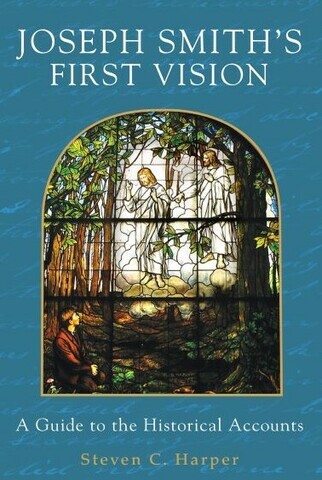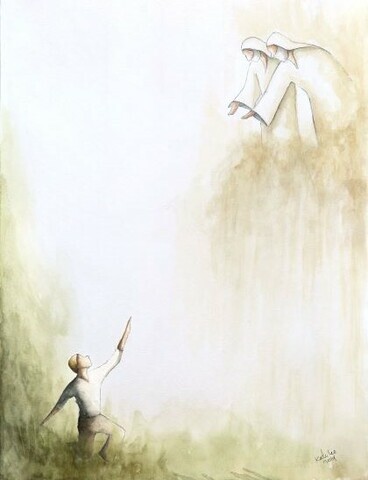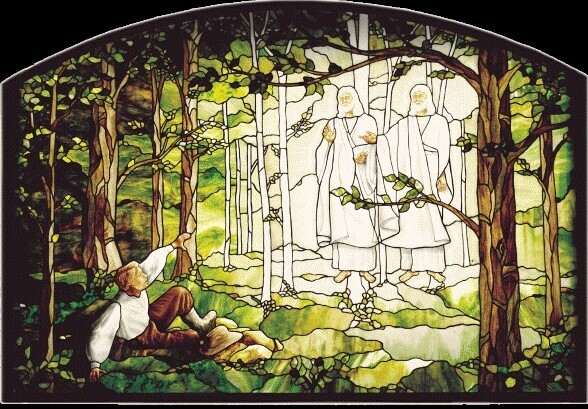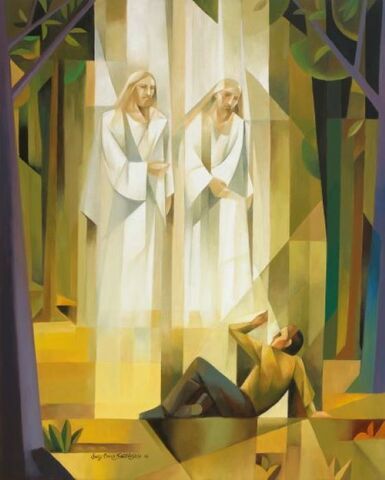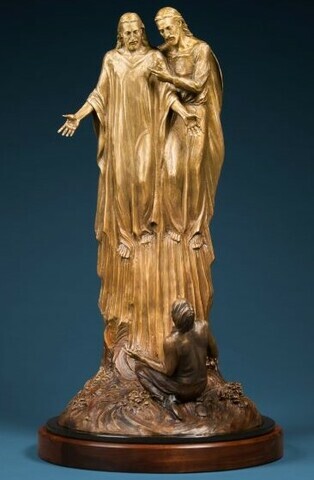*This story originally appeared in the March/April 2020 issue of LDS Living.
As we celebrate the 200th anniversary of the First Vision this spring, explore that miraculous and life-changing event through the eyes of Latter-day Saint artists, musicians, and writers who have worked to portray it.
Jorge Cocco Santángelo—The First Vision
“The first question I asked the missionaries at the time of my conversion was, ‘Why aren’t there prophets today as there were in the olden times?’” says Argentinian artist Jorge Cocco Santángelo. The artist is world-renowned for his craft, and in recent years, he has come to be known for his unique “sacrocubism” style of portraying the connection between the earthly and the divine.
► You'll also like: How a World-Renowned Artist Converted to the Church and Shares His Faith Through Unique Art
In 1962, Santángelo and his wife, Myriam, joined the Church. That conversion gave his art purpose, and he quickly started painting gospel themes, including the First Vision. His painting entitled First Vision beautifully portrays subtle but specific details about the sacred event through colors and lines. “The two celestial personages are dressed in white and surrounded by vertical, luminous, descending rays,” Santángelo explains. “This effect provokes feelings of inspiration and elevation for the viewer. On the other hand, Joseph’s figure forms angles and diagonals indicating his recent struggle with the enemy.”
But Santángelo also took great care not to limit his viewers and to always point them back to the true purpose of the vision. “I tried to avoid including obvious details. For instance, the grove is only suggested. This was done to focus the attention on the main event, which was that God the Father and the Son appeared to Joseph.” He adds, “The account of this event was the basis to build my testimony of the restored gospel. As such, I felt the need to express this glorious event with my art.”
Rob Gardner—Joseph Smith the Prophet
Acclaimed composer, producer, and conductor Rob Gardner had just returned from his mission when he took a class about Joseph Smith from a dynamic professor who forever impacted him. “I just remember thinking, ‘I wish I could do in music what he’s doing for me in his class . . . having people feel the same way that I do in his class, wanting to know more,’” Gardner says.
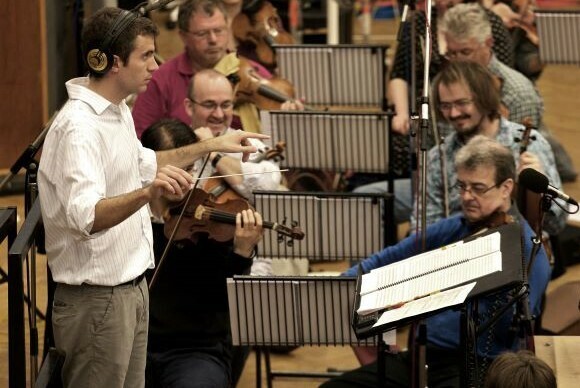
Gardner, who has crafted sacred oratories, stage musicals, and original works for film as well as recorded with the London Symphony Orchestra, had a special purpose in mind as he began composing a piece about Joseph Smith in the early 2000s. “I wanted to use as many of the Prophet’s words as possible and other people who actually knew him,” Gardner says of his oratorio Joseph Smith: The Prophet.
► You'll also like: All In E24: Rob Gardner: Portraying the Savior in Music
In order to achieve this goal, Gardner’s composition uses Joseph’s own words from Joseph Smith—History, Lucy Mack Smith’s history of her son, first-person histories, and even some talks about Joseph Smith’s First Vision and the restoration of the Church. The end result has changed the way Gardner thinks about Joseph Smith and the First Vision. “There’s a person behind [the Prophet],” Gardner says. “He was . . . trying to figure things out and having these major difficulties along the way, and that just kind of struck me as very human—to suffer. It’s not just the Liberty Jail stuff. He had [children] die, and what he said about [children who die] was they were ‘too pure, too lovely, to live on earth.’ So I tried to put that in music, too.”
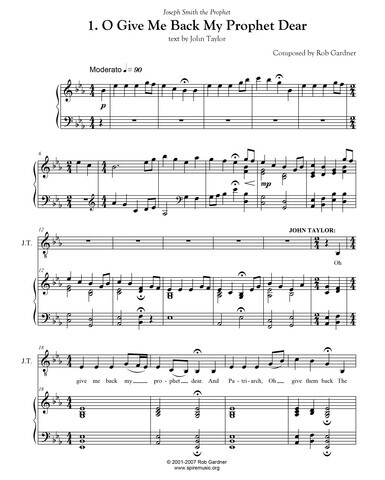
In fact, it is Joseph Smith’s humanness that gives us hope for our own lives. “I think we have this idea in our minds that in order to receive inspiration—or in this case, revelation, which is a step above inspiration—we are supposed to be these perfect beings,” Gardner says. “Joseph had a question, so he went into the grove to get an answer. He didn’t say, ‘Well I’m not ready for the revelation. I’ve got to wait until I repent of this.’ He just went. He studied and prepared himself, but it wasn’t like he had to wait until the perfect day to do it. . . . And I think that’s true of every beautiful thing we have in this world. If we wait until we’re perfect to get it, then it’s never going to happen because we’re never going to be there or believe we’re there.”
If nothing else, Gardner hopes that those experiencing the life of the Prophet Joseph Smith through his music understand that “if you have something to say, go out and say it. Don’t wait for someone to come to you. . . . Joseph went into the grove and didn’t know what to expect, he just did it. It’s a good lesson for us all that if we feel passionate about something or if we have a question, go find the answer.”
Find the soundtracks on Google music and Apple music.
Kraig Varner—First Vision
Kraig Varner is a talented artist who has sculpted works in a wide range of genres. But when he agreed to create a sculpture of the First Vision for the soon-to-be-completed Conference Center in the late 1990s, he faced a unique task. “The biggest challenge was [that] I had never seen a sculpture of the First Vision,” Varner says. As he pondered the style he should pursue, Varner felt he was guided by the Spirit. “Many of the painting depictions showed the Father and Son separated, so I felt impressed to present the sculpture [showing] how a loving Father would be towards his Son,” he says.
► You'll also like: 30 Things You Didn't Know about the Conference Center
Today, Varner hopes that his sculpture, which is still seen by thousands of Conference Center visitors each year, will cause those who see it to think about Joseph Smith’s account of seeing the Father and the Son. The representation emulates Varner’s own feelings about the prayer that led to the Restoration of the Church. “It’s the seminal event,” he says. “It’s God once again talking to man after almost 2,000 years. It’s huge. . . . Everything was so fuzzy [when it came to] God before the vision. Joseph Smith’s vision showed that we are created after the image of God—that’s a very powerful thing.”
Steven C. Harper—Joseph Smith's First Vision: A Guide to the Historical Accounts
Steven C. Harper first learned that there were multiple accounts of the First Vision from his Church history professor while on a travel study trip to Nauvoo. As he continued to have opportunities to study the First Vision and its multiple accounts, he eventually turned to writing books, including Joseph Smith’s First Vision: A Guide to the Historical Accounts and First Vision: Memory and Mormon Origins. Through his studies, Harper has identified a few potential pitfalls we may encounter when studying the First Vision:
1. Assumptions. “Everybody who’s well informed knows the same facts [about the First Vision accounts], and these people are all over the map as far as belief goes,” Harper says. “It’s very clear that knowing the facts of the First Vision accounts doesn’t necessarily increase your faith [or] decrease your faith, so there must be something else that is at work there.” He continues, “The people I’m most concerned about are the ones who haven’t learned or been taught to think historically or think about historical documents. They often then bring assumptions to the table without knowing it . . . and when they find their assumptions challenged, they then question everything along with them.”
2. Interpreting sources. Harper explains that learning about the First Vision accounts from his Church history professor in Nauvoo made all the difference in how he reacted to them. “That interpretation was faithful,” he says. “Other people are getting the facts from sites or places where the interpretation is unfaithful and unbelieving, and they’re not sometimes very good at . . . being able to pull the facts and the interpretation of them apart from each other.” He continues, “My great goal is to help people . . . gain the skills for noticing the difference between the facts and the interpretations and deciding for themselves which interpretation they’re going to choose.”
3. “Hypothetical history.” Harper explains, “[Hypothetical history] is not based on any records from the past. It’s not based on listening to Joseph and finding out what he actually said happened. It’s just based on what I assume would happen—and that’s just based on imagination.” The problem with this, he says, is that “hypothetical history” is “easy to challenge and overturn. It is very easy to disprove it, and then we wonder if anything we ever believed or were taught is true.”
When it comes down to it, though, Harper explains that studying the First Vision accounts can neither strengthen nor weaken your testimony on their own. “I don’t study Church history because my testimony is weaker and I need it to get stronger,” he says. “The things that are most strengthening to my faith are personal experiences with God—the same things that strengthen other people’s faith. . . . the cornerstone of it is my personal experience with the Book of Mormon.”
You can learn more about the First Vision from Steven Harper this year at stevencraigharper.com.
Kate Lee—First Vision
Kate Lee recently emerged in the Latter-day Saint artistic world with a unique minimalistic style to her watercolor paintings. Through her art, Lee, who has dealt with sometimes crippling insecurity and self-doubt throughout her life, has found a voice to share the message of God’s love for His children—a message that she now strongly believes.
► You'll also like: All In E48: Kate Lee: Overcoming Paralyzing Self-Doubt
In her recent portrayal of Joseph Smith’s Sacred Grove experience, First Vision, Lee thought deeply about how to represent God’s love in the details of the painting.
“Joseph, the way he’s reaching up—I really wanted it to be a desperate, ‘You are my Father, and even though I know you, I’m meeting you for the first time.’ And I wanted both Heavenly Father and Christ to be reaching back because that desperation to be together, I feel, is equal. Heavenly Father misses us so much, and I wanted that to be portrayed in the painting.” That theme of “reaching” gives Lee hope when she feels forgotten and is a reminder of God’s love for each of us and His desire to connect with us like He did with Joseph Smith.
“I think that God really does answer our prayers, especially when they are heartfelt and in desperate need of getting answers,” she says. “He is reaching out to me every single second of every day because He wants me to be successful and to return home to Him and to partake of all the goodness that He’s offering us.”
Tom and Gayle Holdman—The First Vision (Stained Glass Window)
Husband and wife team Tom and Gayle Holdman have crafted stained glass windows for dozens of temples around the world. But it all started with an iconic and Church history-significant temple in Palmyra, New York, where the original 100-acre Smith farm once sat.
► You'll also like: The Couple Behind Windows in 80 Temples + Miracles Creating Stained Glass for Rome, Texas, and More
“We will never forget the overwhelming feeling that accompanied the task of visually representing an experience that Joseph himself said defied ‘all description,’” Gayle says. “We made it a matter of intense prayer, and Tom sought specific inspiration for the design in the temple.”
The Holdmans knew that a special window was needed for the Palmyra temple. “We wanted temple patrons to feel Joseph’s sense of awe and wonder,” Gayle explains. “We hope that our piece [continues to suggest] thoughts of the eternal impact of such a vision. That moment is eternally significant to all of God’s children on the earth, and temple covenants can be made and blessings received as a direct result.”

With this goal in mind, Tom and Gayle tried to incorporate the vision of the Father and the Son in several aspects of the temple glasswork. For instance, they beveled, or sloped, the edges of crystal leaves in each exterior window of the temple, refracting the light and allowing temple patrons to, as Gayle says, “Perhaps feel in a small way what Joseph might have felt as he saw the glorious light coming through the trees encasing God the Father and His Son, as if the leaves were on fire.” Additionally, all 108 windows in the temple represent the grove and how “each of us can have personal witnesses of truth in the temple as Joseph received truth in the Sacred Grove.”
A third glass representation of the First Vision is found in the baptistry skylight. “In the octagon, it is a scene of you looking up through the trees,” Gayle explains. “The outer edges are sky blue with a brilliant yellow-white center, as if you are viewing the light coming down when you are in the font.” Tom and Gayle’s testimonies of the First Vision have grown as they have worked on these sacred windows. “For myself, the First Vision influences my entire existence,” Gayle says. “The knowledge that I have a literal Father in Heaven, that I am a child of Deity, created in His image, that I can relate to Him as a tangible being, and that He has a specific plan for me and for all of us gives me a sense of meaning and purpose beyond anything else I have found in my life. . . . How could any other knowledge or experience ever provide more for a human soul?”
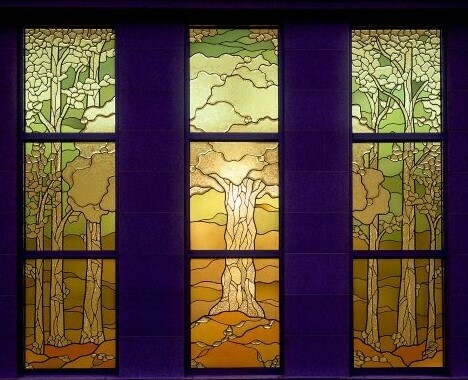
Tom agrees. “Every opportunity we have to illustrate in glass any aspect of the gospel increases our knowledge of and gratitude for that principle. The First Vision is both profoundly grand and intimately personal. Working on that piece and on that temple allowed us to repeatedly feel the Spirit’s witness that the First Vision is a reality, along with all subsequent miracles and revelations having to do with the Restoration.”
BONUS: Portraying Joseph
Dozens of men have portrayed the Prophet Joseph Smith in film over the years, but there are three who are arguably the most recognizable. Here are a few insights from them on what it is like to portray such an iconic prophet and person.
Nathan Mitchell
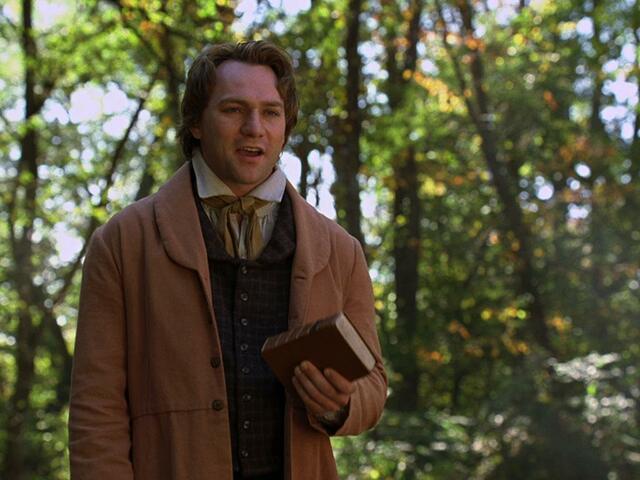
Image from IMDB
Many members of the Church will recognize Nathan Mitchell from his role in Joseph Smith: The Prophet of the Restoration. As the most familiar adult Joseph Smith actor, Nathan Mitchell has portrayed many moments of the Prophet’s life—from his marriage and role as a father to his persecution and martyrdom—and has come to love Joseph Smith as he has done so. In a 2005 Deseret News article, Mitchell shared an insight into his experience: “I think I’ve come to know [Joseph Smith] in a way few have had the opportunity to do. Through that process I believe I know him quite intimately. . . . Since filming finished . . . I’ve realized how much I miss him” (“Movie Opens Today About LDS Founder,” Deseret News, 2005).
Nick Whitaker
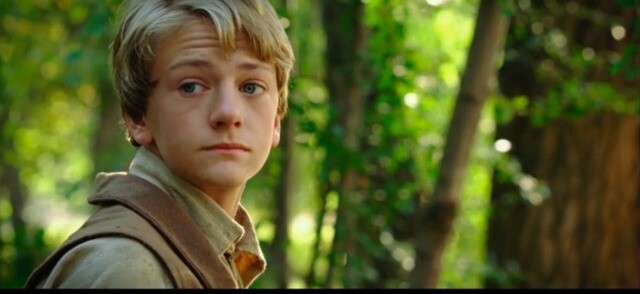
Image a screenshot from Joseph Smith: The Prophet of the Restoration
A veteran actor who has played roles in Disney Channel movies and various theater productions across the Utah Valley, Nick Whitaker is probably better known by members of the Church as the teenage Joseph Smith in Joseph Smith: The Prophet of the Restoration. Whitaker—acting alongside his brother Max, who was playing the part of Joseph Smith’s younger brother William—said in a 2005 New Era article that the experience grew his testimony of the Prophet.
“I’ve gotten to know Joseph Smith a lot better,” Nick said in the article. “I only knew the highlights of his life before. But even the little parts of his life are highlights now. I know he is a true prophet” (“Playing Joseph Smith,” November 2005 New Era).
Dustin Harding
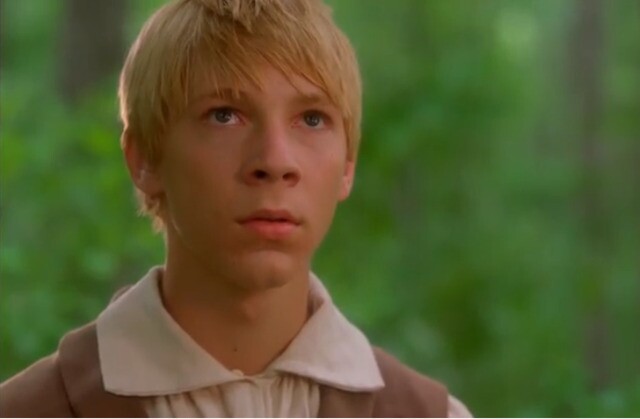
Image a screenshot from The Restoration
Unlike most missionaries entering the MTC, Dusting Harding was almost instantly recognizable to everyone he met. That’s because only a few months before Harding entered the MTC, the Church had distributed a DVD called The Restoration, which was also played for the MTC missionaries. The person playing the teenage Joseph Smith? Harding. Since the film’s release in the early 2000s, many Latter-day Saints have recognized him for playing the part of Joseph Smith, but Harding doesn’t mind. In a 2004 Church News article, he shares, “I’ve kind of looked at this as an opportunity to bear my testimony. Every time somebody comes up to me and asks if I portrayed Joseph Smith, I have an opportunity to bear my testimony about the Prophet Joseph Smith and tell them how much I love that man” (“Joseph Smith: ‘Prophet of the Restoration,' Church News, 2004).
All images courtesy of the authors and artists unless otherwise indicated
